Business Risk Management Assignment 2022
VerifiedAdded on 2022/10/10
|12
|2996
|20
Assignment
AI Summary
Contribute Materials
Your contribution can guide someone’s learning journey. Share your
documents today.
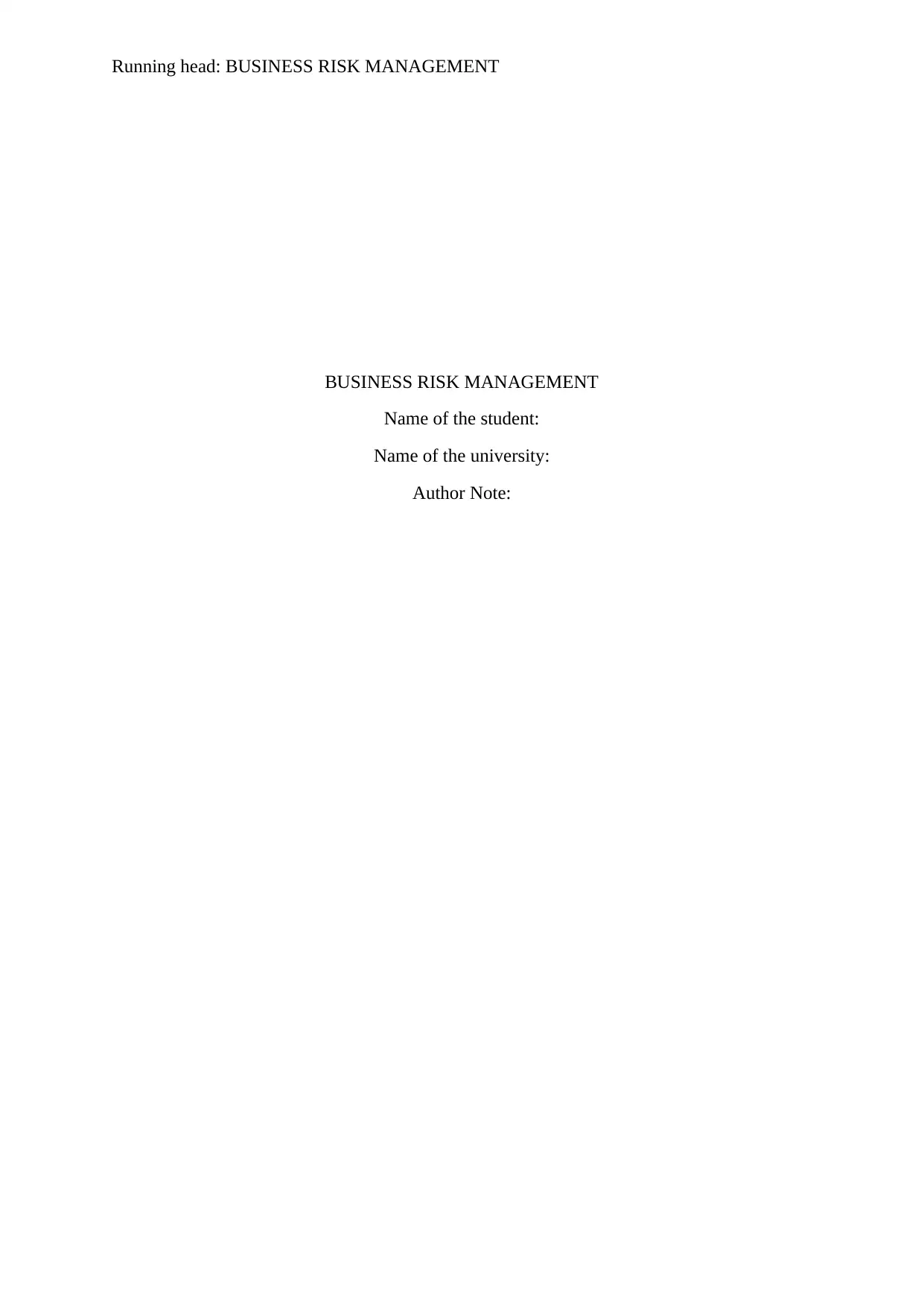
Running head: BUSINESS RISK MANAGEMENT
BUSINESS RISK MANAGEMENT
Name of the student:
Name of the university:
Author Note:
BUSINESS RISK MANAGEMENT
Name of the student:
Name of the university:
Author Note:
Secure Best Marks with AI Grader
Need help grading? Try our AI Grader for instant feedback on your assignments.
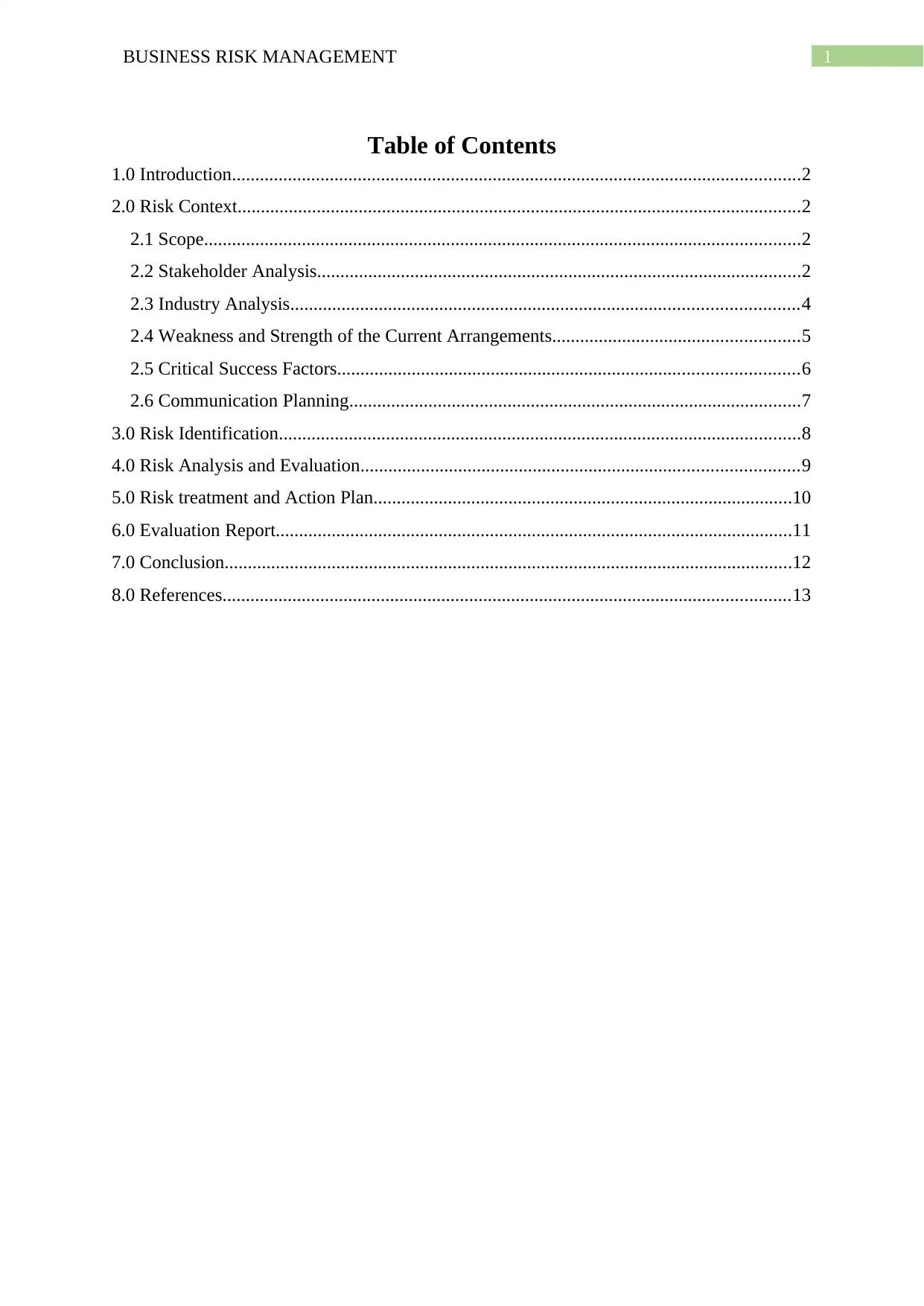
1BUSINESS RISK MANAGEMENT
Table of Contents
1.0 Introduction..........................................................................................................................2
2.0 Risk Context.........................................................................................................................2
2.1 Scope................................................................................................................................2
2.2 Stakeholder Analysis........................................................................................................2
2.3 Industry Analysis.............................................................................................................4
2.4 Weakness and Strength of the Current Arrangements.....................................................5
2.5 Critical Success Factors...................................................................................................6
2.6 Communication Planning.................................................................................................7
3.0 Risk Identification................................................................................................................8
4.0 Risk Analysis and Evaluation..............................................................................................9
5.0 Risk treatment and Action Plan..........................................................................................10
6.0 Evaluation Report...............................................................................................................11
7.0 Conclusion..........................................................................................................................12
8.0 References..........................................................................................................................13
Table of Contents
1.0 Introduction..........................................................................................................................2
2.0 Risk Context.........................................................................................................................2
2.1 Scope................................................................................................................................2
2.2 Stakeholder Analysis........................................................................................................2
2.3 Industry Analysis.............................................................................................................4
2.4 Weakness and Strength of the Current Arrangements.....................................................5
2.5 Critical Success Factors...................................................................................................6
2.6 Communication Planning.................................................................................................7
3.0 Risk Identification................................................................................................................8
4.0 Risk Analysis and Evaluation..............................................................................................9
5.0 Risk treatment and Action Plan..........................................................................................10
6.0 Evaluation Report...............................................................................................................11
7.0 Conclusion..........................................................................................................................12
8.0 References..........................................................................................................................13
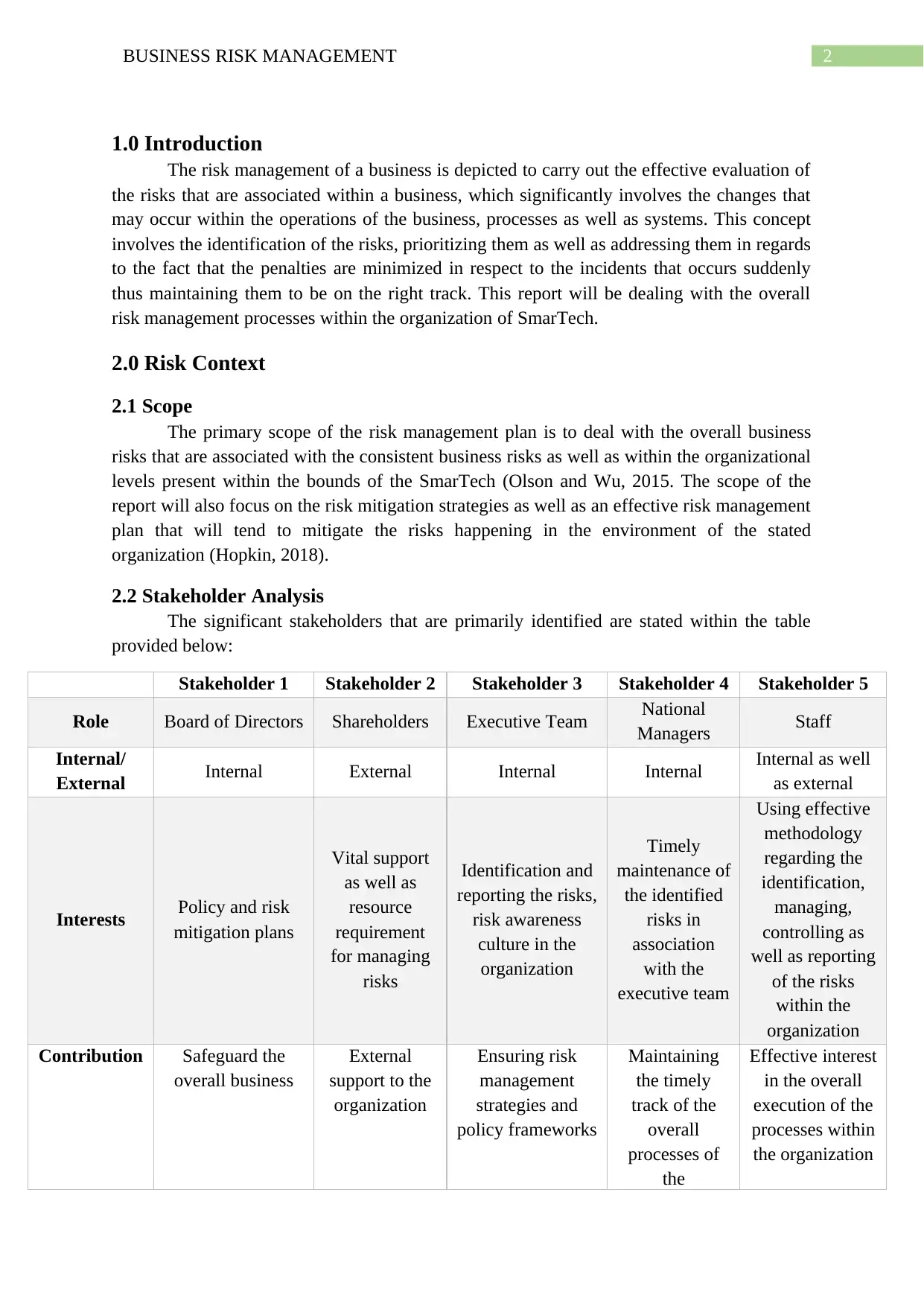
2BUSINESS RISK MANAGEMENT
1.0 Introduction
The risk management of a business is depicted to carry out the effective evaluation of
the risks that are associated within a business, which significantly involves the changes that
may occur within the operations of the business, processes as well as systems. This concept
involves the identification of the risks, prioritizing them as well as addressing them in regards
to the fact that the penalties are minimized in respect to the incidents that occurs suddenly
thus maintaining them to be on the right track. This report will be dealing with the overall
risk management processes within the organization of SmarTech.
2.0 Risk Context
2.1 Scope
The primary scope of the risk management plan is to deal with the overall business
risks that are associated with the consistent business risks as well as within the organizational
levels present within the bounds of the SmarTech (Olson and Wu, 2015. The scope of the
report will also focus on the risk mitigation strategies as well as an effective risk management
plan that will tend to mitigate the risks happening in the environment of the stated
organization (Hopkin, 2018).
2.2 Stakeholder Analysis
The significant stakeholders that are primarily identified are stated within the table
provided below:
Stakeholder 1 Stakeholder 2 Stakeholder 3 Stakeholder 4 Stakeholder 5
Role Board of Directors Shareholders Executive Team National
Managers Staff
Internal/
External Internal External Internal Internal Internal as well
as external
Interests Policy and risk
mitigation plans
Vital support
as well as
resource
requirement
for managing
risks
Identification and
reporting the risks,
risk awareness
culture in the
organization
Timely
maintenance of
the identified
risks in
association
with the
executive team
Using effective
methodology
regarding the
identification,
managing,
controlling as
well as reporting
of the risks
within the
organization
Contribution Safeguard the
overall business
External
support to the
organization
Ensuring risk
management
strategies and
policy frameworks
Maintaining
the timely
track of the
overall
processes of
the
Effective interest
in the overall
execution of the
processes within
the organization
1.0 Introduction
The risk management of a business is depicted to carry out the effective evaluation of
the risks that are associated within a business, which significantly involves the changes that
may occur within the operations of the business, processes as well as systems. This concept
involves the identification of the risks, prioritizing them as well as addressing them in regards
to the fact that the penalties are minimized in respect to the incidents that occurs suddenly
thus maintaining them to be on the right track. This report will be dealing with the overall
risk management processes within the organization of SmarTech.
2.0 Risk Context
2.1 Scope
The primary scope of the risk management plan is to deal with the overall business
risks that are associated with the consistent business risks as well as within the organizational
levels present within the bounds of the SmarTech (Olson and Wu, 2015. The scope of the
report will also focus on the risk mitigation strategies as well as an effective risk management
plan that will tend to mitigate the risks happening in the environment of the stated
organization (Hopkin, 2018).
2.2 Stakeholder Analysis
The significant stakeholders that are primarily identified are stated within the table
provided below:
Stakeholder 1 Stakeholder 2 Stakeholder 3 Stakeholder 4 Stakeholder 5
Role Board of Directors Shareholders Executive Team National
Managers Staff
Internal/
External Internal External Internal Internal Internal as well
as external
Interests Policy and risk
mitigation plans
Vital support
as well as
resource
requirement
for managing
risks
Identification and
reporting the risks,
risk awareness
culture in the
organization
Timely
maintenance of
the identified
risks in
association
with the
executive team
Using effective
methodology
regarding the
identification,
managing,
controlling as
well as reporting
of the risks
within the
organization
Contribution Safeguard the
overall business
External
support to the
organization
Ensuring risk
management
strategies and
policy frameworks
Maintaining
the timely
track of the
overall
processes of
the
Effective interest
in the overall
execution of the
processes within
the organization
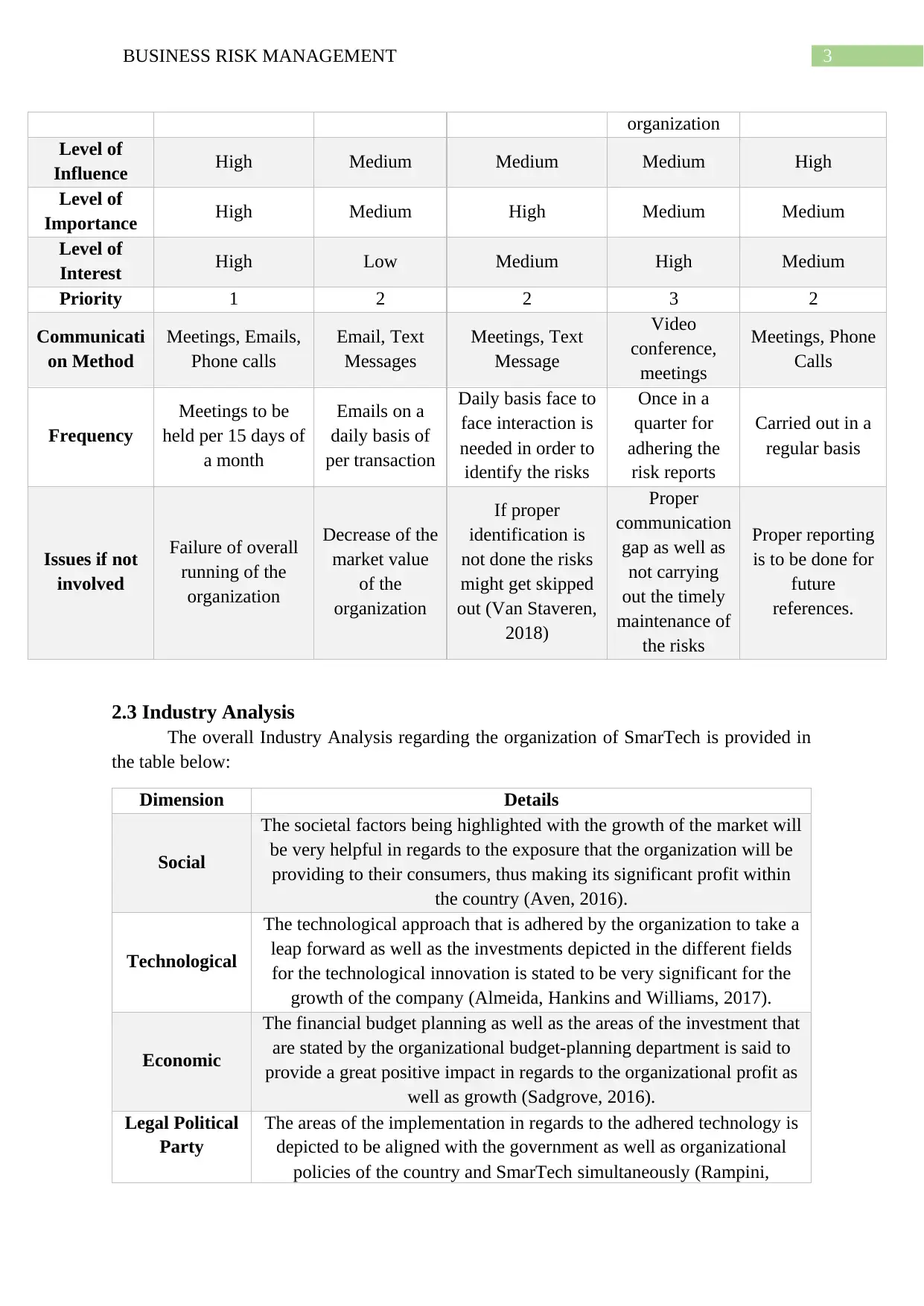
3BUSINESS RISK MANAGEMENT
organization
Level of
Influence High Medium Medium Medium High
Level of
Importance High Medium High Medium Medium
Level of
Interest High Low Medium High Medium
Priority 1 2 2 3 2
Communicati
on Method
Meetings, Emails,
Phone calls
Email, Text
Messages
Meetings, Text
Message
Video
conference,
meetings
Meetings, Phone
Calls
Frequency
Meetings to be
held per 15 days of
a month
Emails on a
daily basis of
per transaction
Daily basis face to
face interaction is
needed in order to
identify the risks
Once in a
quarter for
adhering the
risk reports
Carried out in a
regular basis
Issues if not
involved
Failure of overall
running of the
organization
Decrease of the
market value
of the
organization
If proper
identification is
not done the risks
might get skipped
out (Van Staveren,
2018)
Proper
communication
gap as well as
not carrying
out the timely
maintenance of
the risks
Proper reporting
is to be done for
future
references.
2.3 Industry Analysis
The overall Industry Analysis regarding the organization of SmarTech is provided in
the table below:
Dimension Details
Social
The societal factors being highlighted with the growth of the market will
be very helpful in regards to the exposure that the organization will be
providing to their consumers, thus making its significant profit within
the country (Aven, 2016).
Technological
The technological approach that is adhered by the organization to take a
leap forward as well as the investments depicted in the different fields
for the technological innovation is stated to be very significant for the
growth of the company (Almeida, Hankins and Williams, 2017).
Economic
The financial budget planning as well as the areas of the investment that
are stated by the organizational budget-planning department is said to
provide a great positive impact in regards to the organizational profit as
well as growth (Sadgrove, 2016).
Legal Political
Party
The areas of the implementation in regards to the adhered technology is
depicted to be aligned with the government as well as organizational
policies of the country and SmarTech simultaneously (Rampini,
organization
Level of
Influence High Medium Medium Medium High
Level of
Importance High Medium High Medium Medium
Level of
Interest High Low Medium High Medium
Priority 1 2 2 3 2
Communicati
on Method
Meetings, Emails,
Phone calls
Email, Text
Messages
Meetings, Text
Message
Video
conference,
meetings
Meetings, Phone
Calls
Frequency
Meetings to be
held per 15 days of
a month
Emails on a
daily basis of
per transaction
Daily basis face to
face interaction is
needed in order to
identify the risks
Once in a
quarter for
adhering the
risk reports
Carried out in a
regular basis
Issues if not
involved
Failure of overall
running of the
organization
Decrease of the
market value
of the
organization
If proper
identification is
not done the risks
might get skipped
out (Van Staveren,
2018)
Proper
communication
gap as well as
not carrying
out the timely
maintenance of
the risks
Proper reporting
is to be done for
future
references.
2.3 Industry Analysis
The overall Industry Analysis regarding the organization of SmarTech is provided in
the table below:
Dimension Details
Social
The societal factors being highlighted with the growth of the market will
be very helpful in regards to the exposure that the organization will be
providing to their consumers, thus making its significant profit within
the country (Aven, 2016).
Technological
The technological approach that is adhered by the organization to take a
leap forward as well as the investments depicted in the different fields
for the technological innovation is stated to be very significant for the
growth of the company (Almeida, Hankins and Williams, 2017).
Economic
The financial budget planning as well as the areas of the investment that
are stated by the organizational budget-planning department is said to
provide a great positive impact in regards to the organizational profit as
well as growth (Sadgrove, 2016).
Legal Political
Party
The areas of the implementation in regards to the adhered technology is
depicted to be aligned with the government as well as organizational
policies of the country and SmarTech simultaneously (Rampini,
Secure Best Marks with AI Grader
Need help grading? Try our AI Grader for instant feedback on your assignments.
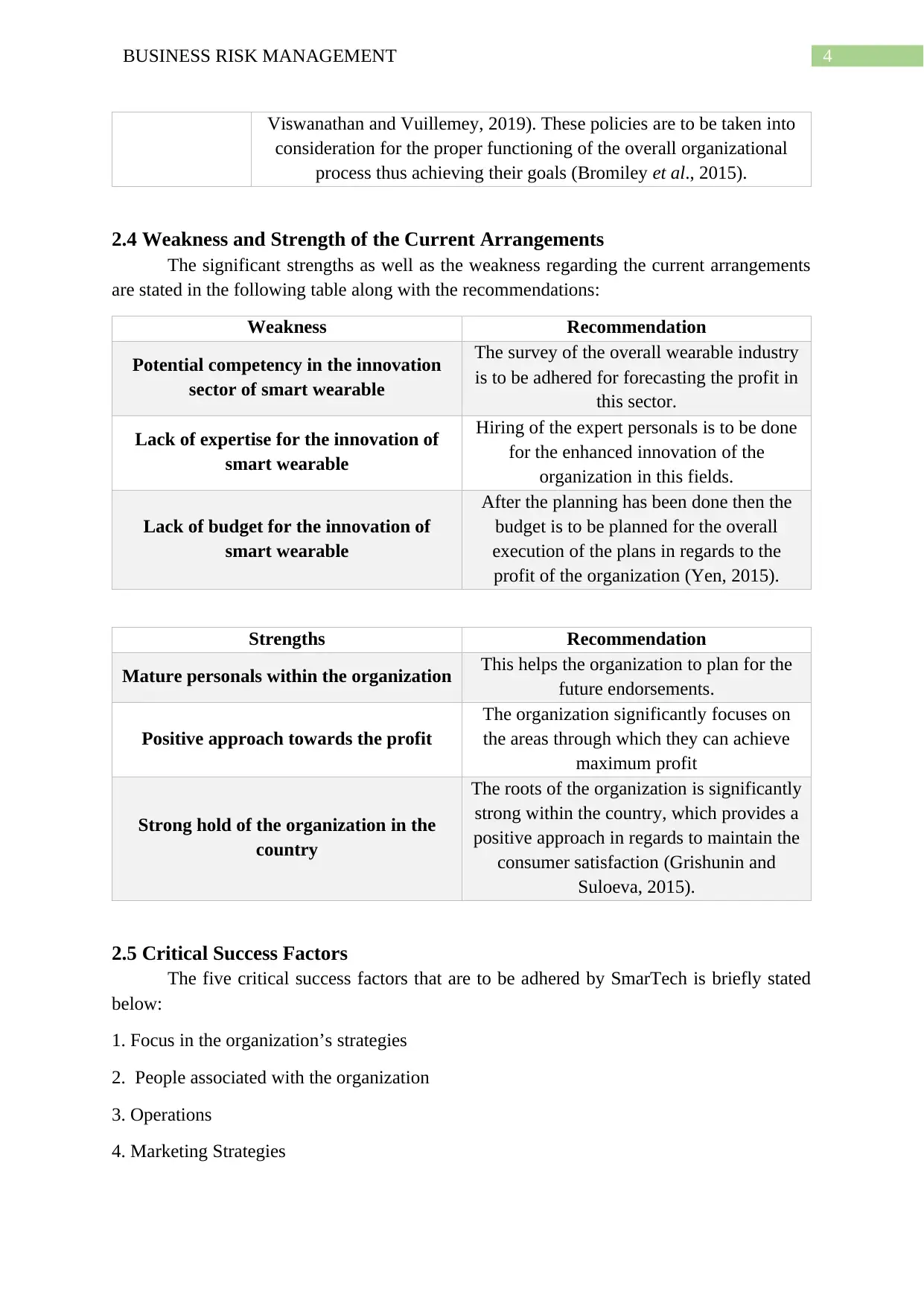
4BUSINESS RISK MANAGEMENT
Viswanathan and Vuillemey, 2019). These policies are to be taken into
consideration for the proper functioning of the overall organizational
process thus achieving their goals (Bromiley et al., 2015).
2.4 Weakness and Strength of the Current Arrangements
The significant strengths as well as the weakness regarding the current arrangements
are stated in the following table along with the recommendations:
Weakness Recommendation
Potential competency in the innovation
sector of smart wearable
The survey of the overall wearable industry
is to be adhered for forecasting the profit in
this sector.
Lack of expertise for the innovation of
smart wearable
Hiring of the expert personals is to be done
for the enhanced innovation of the
organization in this fields.
Lack of budget for the innovation of
smart wearable
After the planning has been done then the
budget is to be planned for the overall
execution of the plans in regards to the
profit of the organization (Yen, 2015).
Strengths Recommendation
Mature personals within the organization This helps the organization to plan for the
future endorsements.
Positive approach towards the profit
The organization significantly focuses on
the areas through which they can achieve
maximum profit
Strong hold of the organization in the
country
The roots of the organization is significantly
strong within the country, which provides a
positive approach in regards to maintain the
consumer satisfaction (Grishunin and
Suloeva, 2015).
2.5 Critical Success Factors
The five critical success factors that are to be adhered by SmarTech is briefly stated
below:
1. Focus in the organization’s strategies
2. People associated with the organization
3. Operations
4. Marketing Strategies
Viswanathan and Vuillemey, 2019). These policies are to be taken into
consideration for the proper functioning of the overall organizational
process thus achieving their goals (Bromiley et al., 2015).
2.4 Weakness and Strength of the Current Arrangements
The significant strengths as well as the weakness regarding the current arrangements
are stated in the following table along with the recommendations:
Weakness Recommendation
Potential competency in the innovation
sector of smart wearable
The survey of the overall wearable industry
is to be adhered for forecasting the profit in
this sector.
Lack of expertise for the innovation of
smart wearable
Hiring of the expert personals is to be done
for the enhanced innovation of the
organization in this fields.
Lack of budget for the innovation of
smart wearable
After the planning has been done then the
budget is to be planned for the overall
execution of the plans in regards to the
profit of the organization (Yen, 2015).
Strengths Recommendation
Mature personals within the organization This helps the organization to plan for the
future endorsements.
Positive approach towards the profit
The organization significantly focuses on
the areas through which they can achieve
maximum profit
Strong hold of the organization in the
country
The roots of the organization is significantly
strong within the country, which provides a
positive approach in regards to maintain the
consumer satisfaction (Grishunin and
Suloeva, 2015).
2.5 Critical Success Factors
The five critical success factors that are to be adhered by SmarTech is briefly stated
below:
1. Focus in the organization’s strategies
2. People associated with the organization
3. Operations
4. Marketing Strategies
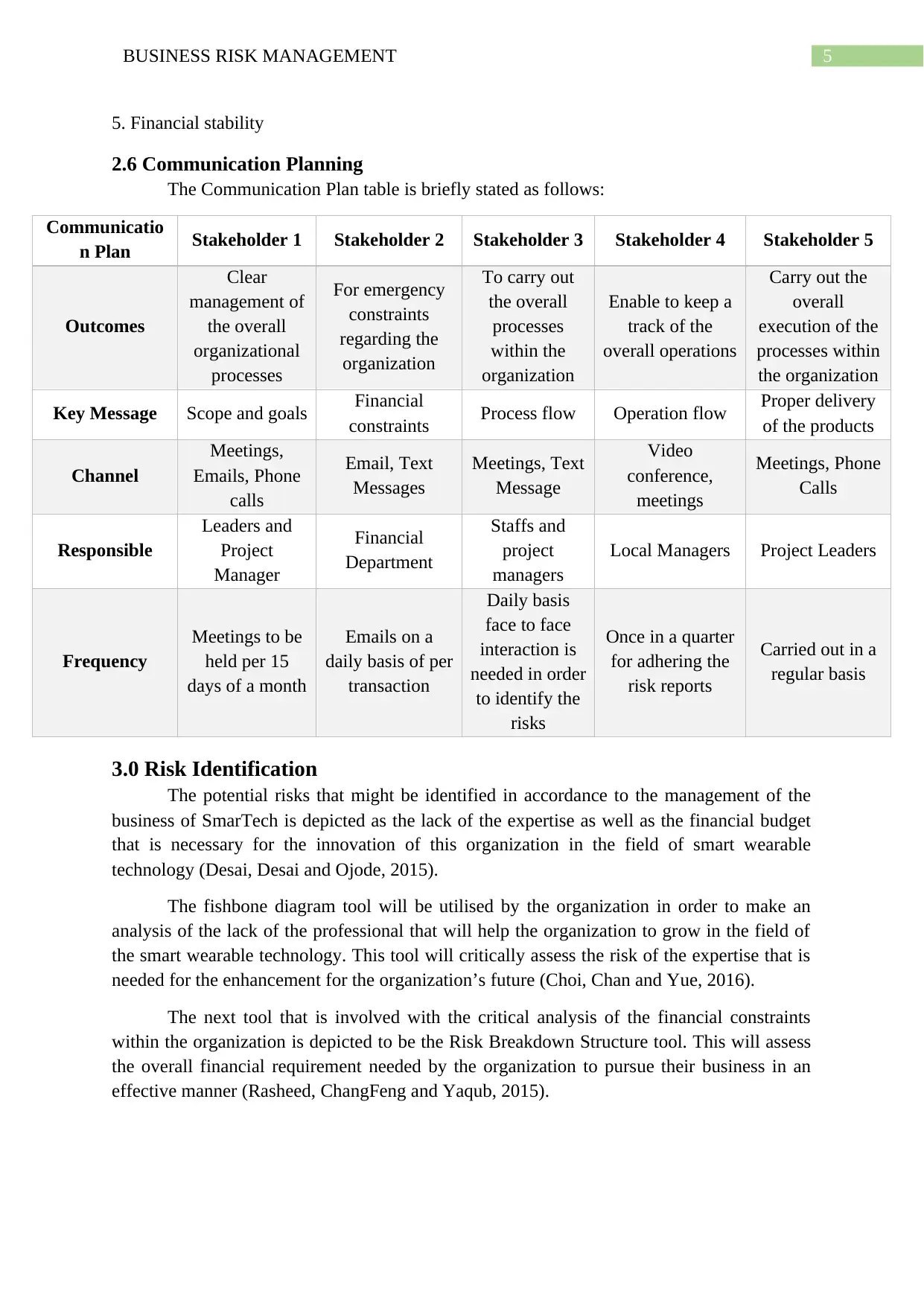
5BUSINESS RISK MANAGEMENT
5. Financial stability
2.6 Communication Planning
The Communication Plan table is briefly stated as follows:
Communicatio
n Plan Stakeholder 1 Stakeholder 2 Stakeholder 3 Stakeholder 4 Stakeholder 5
Outcomes
Clear
management of
the overall
organizational
processes
For emergency
constraints
regarding the
organization
To carry out
the overall
processes
within the
organization
Enable to keep a
track of the
overall operations
Carry out the
overall
execution of the
processes within
the organization
Key Message Scope and goals Financial
constraints Process flow Operation flow Proper delivery
of the products
Channel
Meetings,
Emails, Phone
calls
Email, Text
Messages
Meetings, Text
Message
Video
conference,
meetings
Meetings, Phone
Calls
Responsible
Leaders and
Project
Manager
Financial
Department
Staffs and
project
managers
Local Managers Project Leaders
Frequency
Meetings to be
held per 15
days of a month
Emails on a
daily basis of per
transaction
Daily basis
face to face
interaction is
needed in order
to identify the
risks
Once in a quarter
for adhering the
risk reports
Carried out in a
regular basis
3.0 Risk Identification
The potential risks that might be identified in accordance to the management of the
business of SmarTech is depicted as the lack of the expertise as well as the financial budget
that is necessary for the innovation of this organization in the field of smart wearable
technology (Desai, Desai and Ojode, 2015).
The fishbone diagram tool will be utilised by the organization in order to make an
analysis of the lack of the professional that will help the organization to grow in the field of
the smart wearable technology. This tool will critically assess the risk of the expertise that is
needed for the enhancement for the organization’s future (Choi, Chan and Yue, 2016).
The next tool that is involved with the critical analysis of the financial constraints
within the organization is depicted to be the Risk Breakdown Structure tool. This will assess
the overall financial requirement needed by the organization to pursue their business in an
effective manner (Rasheed, ChangFeng and Yaqub, 2015).
5. Financial stability
2.6 Communication Planning
The Communication Plan table is briefly stated as follows:
Communicatio
n Plan Stakeholder 1 Stakeholder 2 Stakeholder 3 Stakeholder 4 Stakeholder 5
Outcomes
Clear
management of
the overall
organizational
processes
For emergency
constraints
regarding the
organization
To carry out
the overall
processes
within the
organization
Enable to keep a
track of the
overall operations
Carry out the
overall
execution of the
processes within
the organization
Key Message Scope and goals Financial
constraints Process flow Operation flow Proper delivery
of the products
Channel
Meetings,
Emails, Phone
calls
Email, Text
Messages
Meetings, Text
Message
Video
conference,
meetings
Meetings, Phone
Calls
Responsible
Leaders and
Project
Manager
Financial
Department
Staffs and
project
managers
Local Managers Project Leaders
Frequency
Meetings to be
held per 15
days of a month
Emails on a
daily basis of per
transaction
Daily basis
face to face
interaction is
needed in order
to identify the
risks
Once in a quarter
for adhering the
risk reports
Carried out in a
regular basis
3.0 Risk Identification
The potential risks that might be identified in accordance to the management of the
business of SmarTech is depicted as the lack of the expertise as well as the financial budget
that is necessary for the innovation of this organization in the field of smart wearable
technology (Desai, Desai and Ojode, 2015).
The fishbone diagram tool will be utilised by the organization in order to make an
analysis of the lack of the professional that will help the organization to grow in the field of
the smart wearable technology. This tool will critically assess the risk of the expertise that is
needed for the enhancement for the organization’s future (Choi, Chan and Yue, 2016).
The next tool that is involved with the critical analysis of the financial constraints
within the organization is depicted to be the Risk Breakdown Structure tool. This will assess
the overall financial requirement needed by the organization to pursue their business in an
effective manner (Rasheed, ChangFeng and Yaqub, 2015).
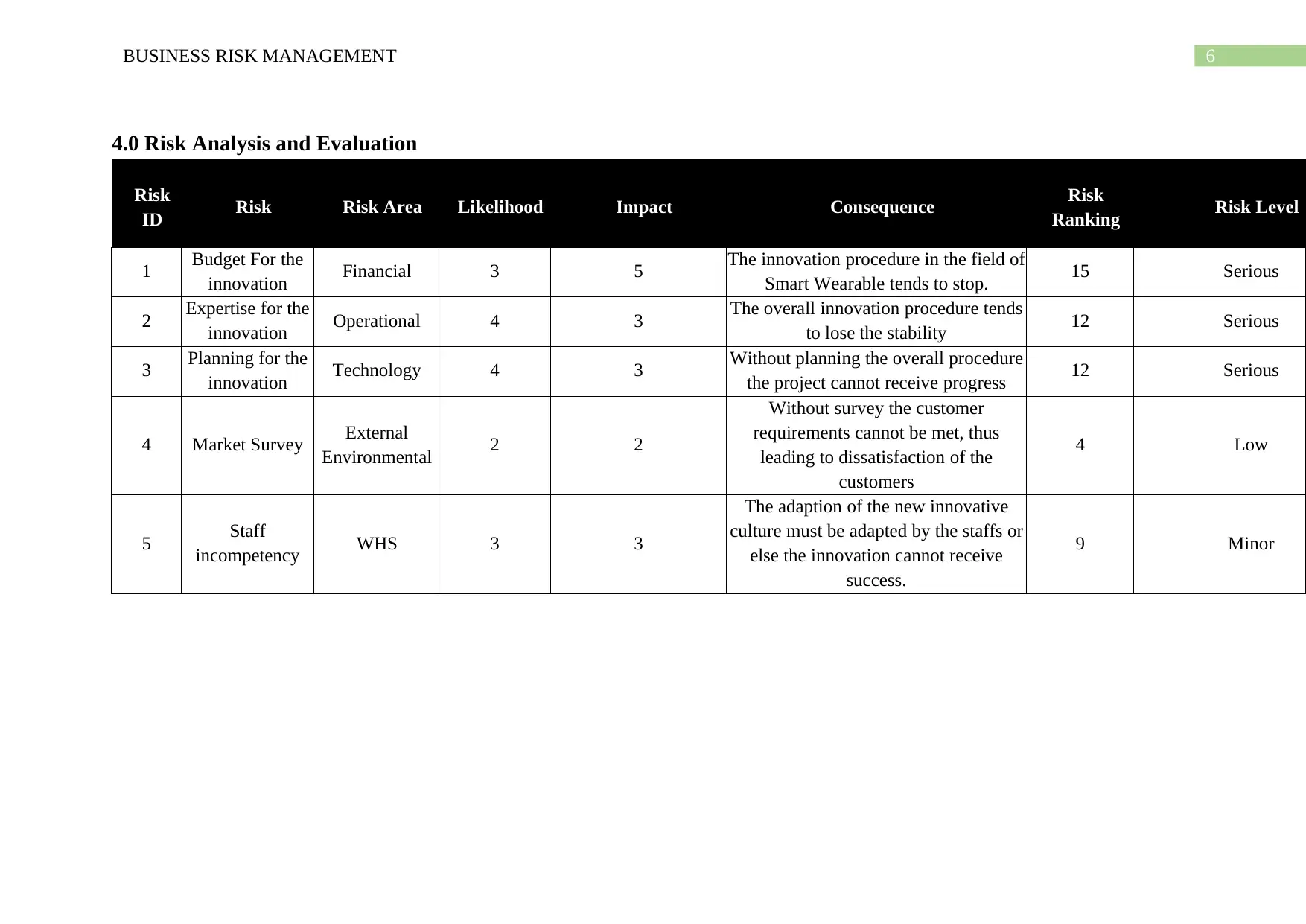
6BUSINESS RISK MANAGEMENT
4.0 Risk Analysis and Evaluation
Risk
ID Risk Risk Area Likelihood Impact Consequence Risk
Ranking Risk Level
1 Budget For the
innovation Financial 3 5 The innovation procedure in the field of
Smart Wearable tends to stop. 15 Serious
2 Expertise for the
innovation Operational 4 3 The overall innovation procedure tends
to lose the stability 12 Serious
3 Planning for the
innovation Technology 4 3 Without planning the overall procedure
the project cannot receive progress 12 Serious
4 Market Survey External
Environmental 2 2
Without survey the customer
requirements cannot be met, thus
leading to dissatisfaction of the
customers
4 Low
5 Staff
incompetency WHS 3 3
The adaption of the new innovative
culture must be adapted by the staffs or
else the innovation cannot receive
success.
9 Minor
4.0 Risk Analysis and Evaluation
Risk
ID Risk Risk Area Likelihood Impact Consequence Risk
Ranking Risk Level
1 Budget For the
innovation Financial 3 5 The innovation procedure in the field of
Smart Wearable tends to stop. 15 Serious
2 Expertise for the
innovation Operational 4 3 The overall innovation procedure tends
to lose the stability 12 Serious
3 Planning for the
innovation Technology 4 3 Without planning the overall procedure
the project cannot receive progress 12 Serious
4 Market Survey External
Environmental 2 2
Without survey the customer
requirements cannot be met, thus
leading to dissatisfaction of the
customers
4 Low
5 Staff
incompetency WHS 3 3
The adaption of the new innovative
culture must be adapted by the staffs or
else the innovation cannot receive
success.
9 Minor
Paraphrase This Document
Need a fresh take? Get an instant paraphrase of this document with our AI Paraphraser
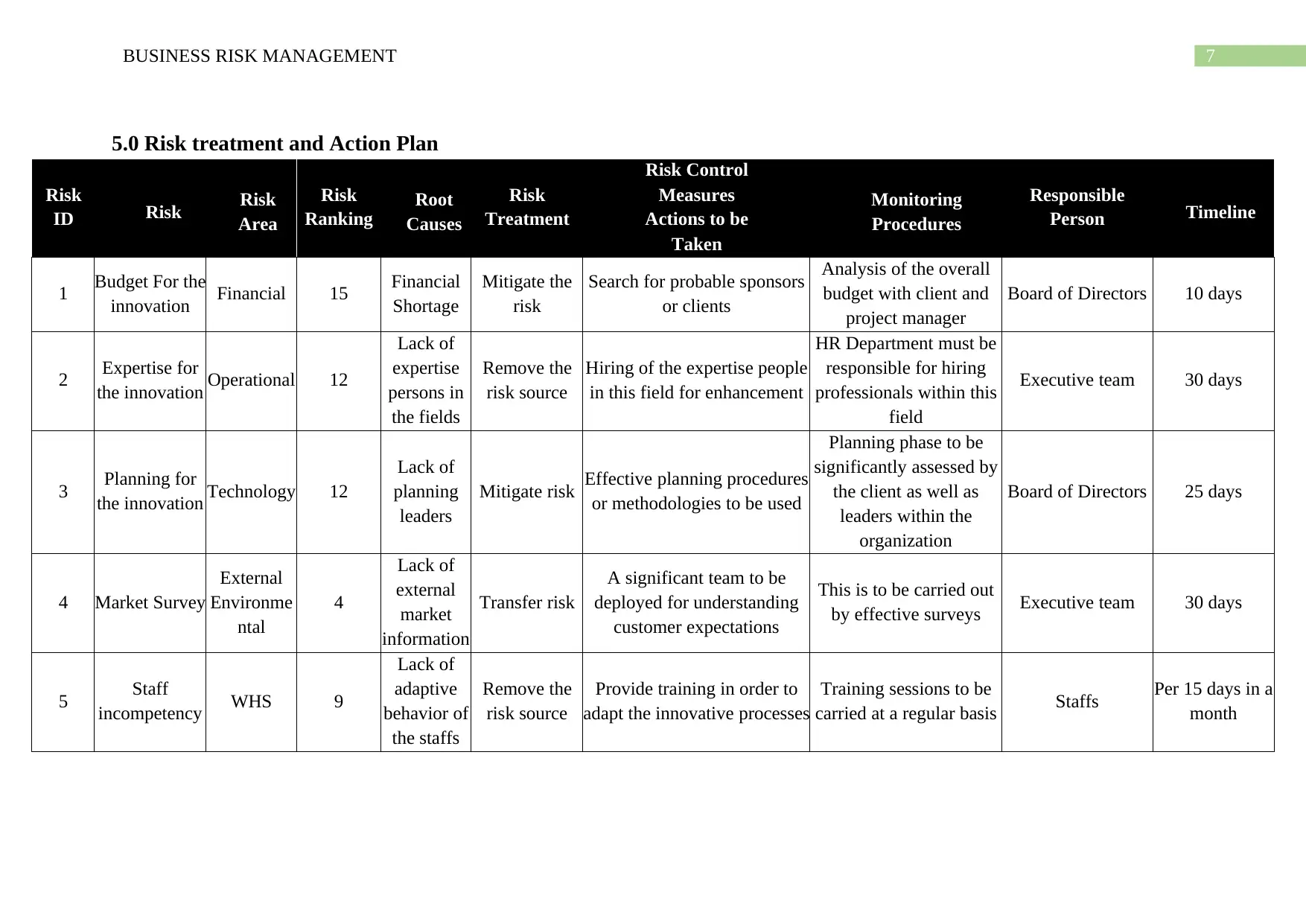
7BUSINESS RISK MANAGEMENT
5.0 Risk treatment and Action Plan
Risk
ID Risk Risk
Area
Risk
Ranking
Root
Causes
Risk
Treatment
Risk Control
Measures
Actions to be
Taken
Monitoring
Procedures
Responsible
Person Timeline
1 Budget For the
innovation Financial 15 Financial
Shortage
Mitigate the
risk
Search for probable sponsors
or clients
Analysis of the overall
budget with client and
project manager
Board of Directors 10 days
2 Expertise for
the innovation Operational 12
Lack of
expertise
persons in
the fields
Remove the
risk source
Hiring of the expertise people
in this field for enhancement
HR Department must be
responsible for hiring
professionals within this
field
Executive team 30 days
3 Planning for
the innovation Technology 12
Lack of
planning
leaders
Mitigate risk Effective planning procedures
or methodologies to be used
Planning phase to be
significantly assessed by
the client as well as
leaders within the
organization
Board of Directors 25 days
4 Market Survey
External
Environme
ntal
4
Lack of
external
market
information
Transfer risk
A significant team to be
deployed for understanding
customer expectations
This is to be carried out
by effective surveys Executive team 30 days
5 Staff
incompetency WHS 9
Lack of
adaptive
behavior of
the staffs
Remove the
risk source
Provide training in order to
adapt the innovative processes
Training sessions to be
carried at a regular basis Staffs Per 15 days in a
month
5.0 Risk treatment and Action Plan
Risk
ID Risk Risk
Area
Risk
Ranking
Root
Causes
Risk
Treatment
Risk Control
Measures
Actions to be
Taken
Monitoring
Procedures
Responsible
Person Timeline
1 Budget For the
innovation Financial 15 Financial
Shortage
Mitigate the
risk
Search for probable sponsors
or clients
Analysis of the overall
budget with client and
project manager
Board of Directors 10 days
2 Expertise for
the innovation Operational 12
Lack of
expertise
persons in
the fields
Remove the
risk source
Hiring of the expertise people
in this field for enhancement
HR Department must be
responsible for hiring
professionals within this
field
Executive team 30 days
3 Planning for
the innovation Technology 12
Lack of
planning
leaders
Mitigate risk Effective planning procedures
or methodologies to be used
Planning phase to be
significantly assessed by
the client as well as
leaders within the
organization
Board of Directors 25 days
4 Market Survey
External
Environme
ntal
4
Lack of
external
market
information
Transfer risk
A significant team to be
deployed for understanding
customer expectations
This is to be carried out
by effective surveys Executive team 30 days
5 Staff
incompetency WHS 9
Lack of
adaptive
behavior of
the staffs
Remove the
risk source
Provide training in order to
adapt the innovative processes
Training sessions to be
carried at a regular basis Staffs Per 15 days in a
month
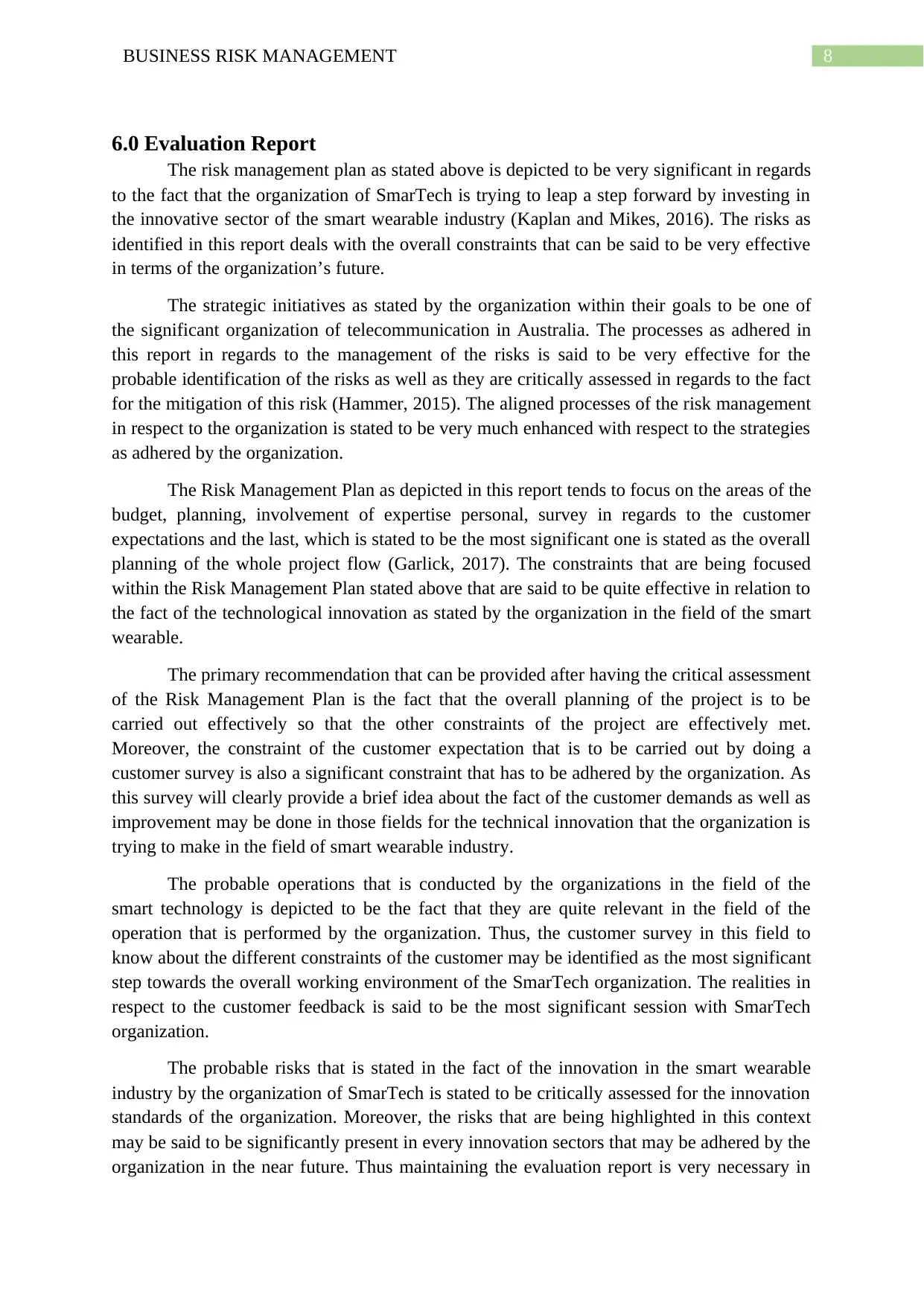
8BUSINESS RISK MANAGEMENT
6.0 Evaluation Report
The risk management plan as stated above is depicted to be very significant in regards
to the fact that the organization of SmarTech is trying to leap a step forward by investing in
the innovative sector of the smart wearable industry (Kaplan and Mikes, 2016). The risks as
identified in this report deals with the overall constraints that can be said to be very effective
in terms of the organization’s future.
The strategic initiatives as stated by the organization within their goals to be one of
the significant organization of telecommunication in Australia. The processes as adhered in
this report in regards to the management of the risks is said to be very effective for the
probable identification of the risks as well as they are critically assessed in regards to the fact
for the mitigation of this risk (Hammer, 2015). The aligned processes of the risk management
in respect to the organization is stated to be very much enhanced with respect to the strategies
as adhered by the organization.
The Risk Management Plan as depicted in this report tends to focus on the areas of the
budget, planning, involvement of expertise personal, survey in regards to the customer
expectations and the last, which is stated to be the most significant one is stated as the overall
planning of the whole project flow (Garlick, 2017). The constraints that are being focused
within the Risk Management Plan stated above that are said to be quite effective in relation to
the fact of the technological innovation as stated by the organization in the field of the smart
wearable.
The primary recommendation that can be provided after having the critical assessment
of the Risk Management Plan is the fact that the overall planning of the project is to be
carried out effectively so that the other constraints of the project are effectively met.
Moreover, the constraint of the customer expectation that is to be carried out by doing a
customer survey is also a significant constraint that has to be adhered by the organization. As
this survey will clearly provide a brief idea about the fact of the customer demands as well as
improvement may be done in those fields for the technical innovation that the organization is
trying to make in the field of smart wearable industry.
The probable operations that is conducted by the organizations in the field of the
smart technology is depicted to be the fact that they are quite relevant in the field of the
operation that is performed by the organization. Thus, the customer survey in this field to
know about the different constraints of the customer may be identified as the most significant
step towards the overall working environment of the SmarTech organization. The realities in
respect to the customer feedback is said to be the most significant session with SmarTech
organization.
The probable risks that is stated in the fact of the innovation in the smart wearable
industry by the organization of SmarTech is stated to be critically assessed for the innovation
standards of the organization. Moreover, the risks that are being highlighted in this context
may be said to be significantly present in every innovation sectors that may be adhered by the
organization in the near future. Thus maintaining the evaluation report is very necessary in
6.0 Evaluation Report
The risk management plan as stated above is depicted to be very significant in regards
to the fact that the organization of SmarTech is trying to leap a step forward by investing in
the innovative sector of the smart wearable industry (Kaplan and Mikes, 2016). The risks as
identified in this report deals with the overall constraints that can be said to be very effective
in terms of the organization’s future.
The strategic initiatives as stated by the organization within their goals to be one of
the significant organization of telecommunication in Australia. The processes as adhered in
this report in regards to the management of the risks is said to be very effective for the
probable identification of the risks as well as they are critically assessed in regards to the fact
for the mitigation of this risk (Hammer, 2015). The aligned processes of the risk management
in respect to the organization is stated to be very much enhanced with respect to the strategies
as adhered by the organization.
The Risk Management Plan as depicted in this report tends to focus on the areas of the
budget, planning, involvement of expertise personal, survey in regards to the customer
expectations and the last, which is stated to be the most significant one is stated as the overall
planning of the whole project flow (Garlick, 2017). The constraints that are being focused
within the Risk Management Plan stated above that are said to be quite effective in relation to
the fact of the technological innovation as stated by the organization in the field of the smart
wearable.
The primary recommendation that can be provided after having the critical assessment
of the Risk Management Plan is the fact that the overall planning of the project is to be
carried out effectively so that the other constraints of the project are effectively met.
Moreover, the constraint of the customer expectation that is to be carried out by doing a
customer survey is also a significant constraint that has to be adhered by the organization. As
this survey will clearly provide a brief idea about the fact of the customer demands as well as
improvement may be done in those fields for the technical innovation that the organization is
trying to make in the field of smart wearable industry.
The probable operations that is conducted by the organizations in the field of the
smart technology is depicted to be the fact that they are quite relevant in the field of the
operation that is performed by the organization. Thus, the customer survey in this field to
know about the different constraints of the customer may be identified as the most significant
step towards the overall working environment of the SmarTech organization. The realities in
respect to the customer feedback is said to be the most significant session with SmarTech
organization.
The probable risks that is stated in the fact of the innovation in the smart wearable
industry by the organization of SmarTech is stated to be critically assessed for the innovation
standards of the organization. Moreover, the risks that are being highlighted in this context
may be said to be significantly present in every innovation sectors that may be adhered by the
organization in the near future. Thus maintaining the evaluation report is very necessary in
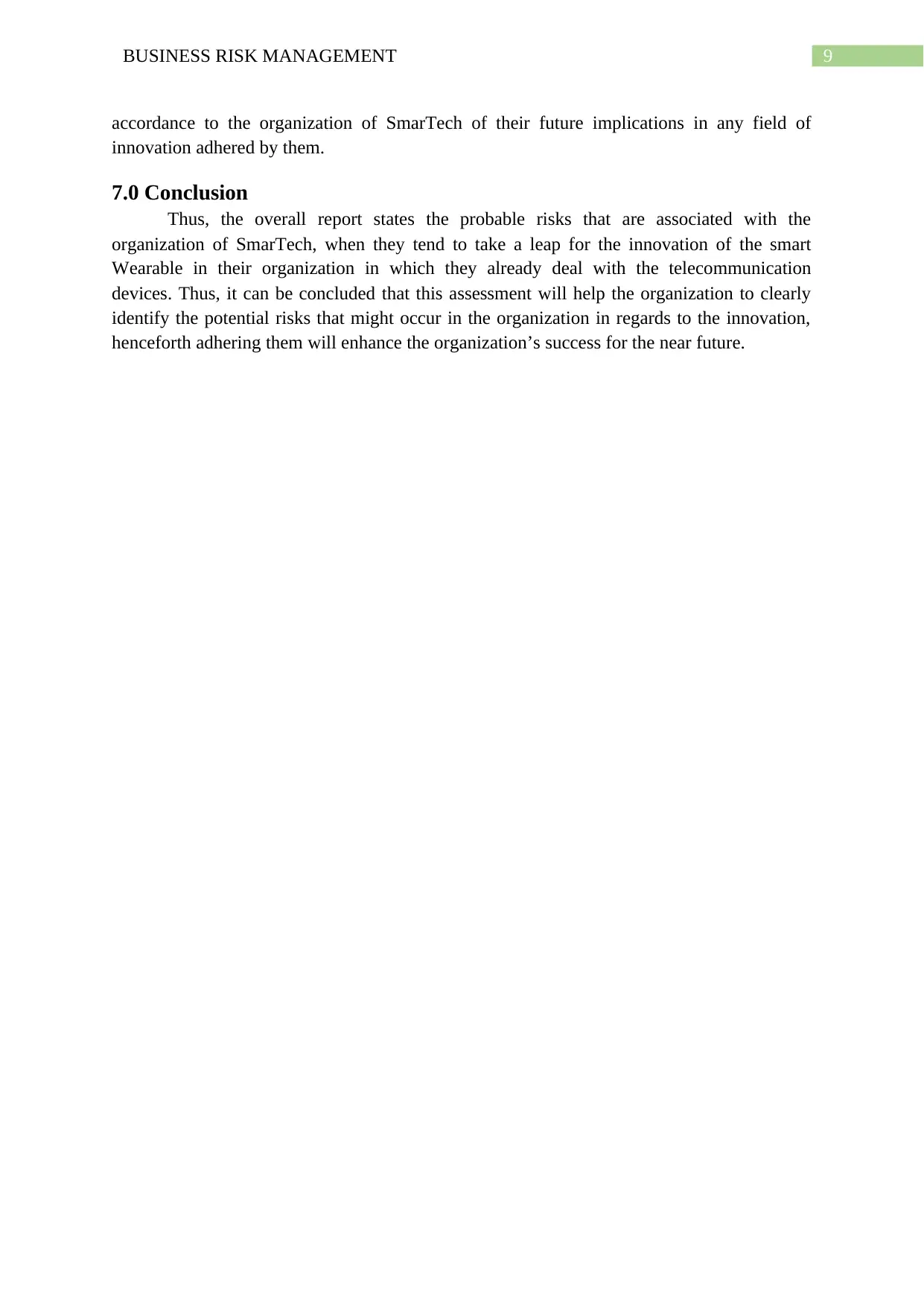
9BUSINESS RISK MANAGEMENT
accordance to the organization of SmarTech of their future implications in any field of
innovation adhered by them.
7.0 Conclusion
Thus, the overall report states the probable risks that are associated with the
organization of SmarTech, when they tend to take a leap for the innovation of the smart
Wearable in their organization in which they already deal with the telecommunication
devices. Thus, it can be concluded that this assessment will help the organization to clearly
identify the potential risks that might occur in the organization in regards to the innovation,
henceforth adhering them will enhance the organization’s success for the near future.
accordance to the organization of SmarTech of their future implications in any field of
innovation adhered by them.
7.0 Conclusion
Thus, the overall report states the probable risks that are associated with the
organization of SmarTech, when they tend to take a leap for the innovation of the smart
Wearable in their organization in which they already deal with the telecommunication
devices. Thus, it can be concluded that this assessment will help the organization to clearly
identify the potential risks that might occur in the organization in regards to the innovation,
henceforth adhering them will enhance the organization’s success for the near future.
Secure Best Marks with AI Grader
Need help grading? Try our AI Grader for instant feedback on your assignments.
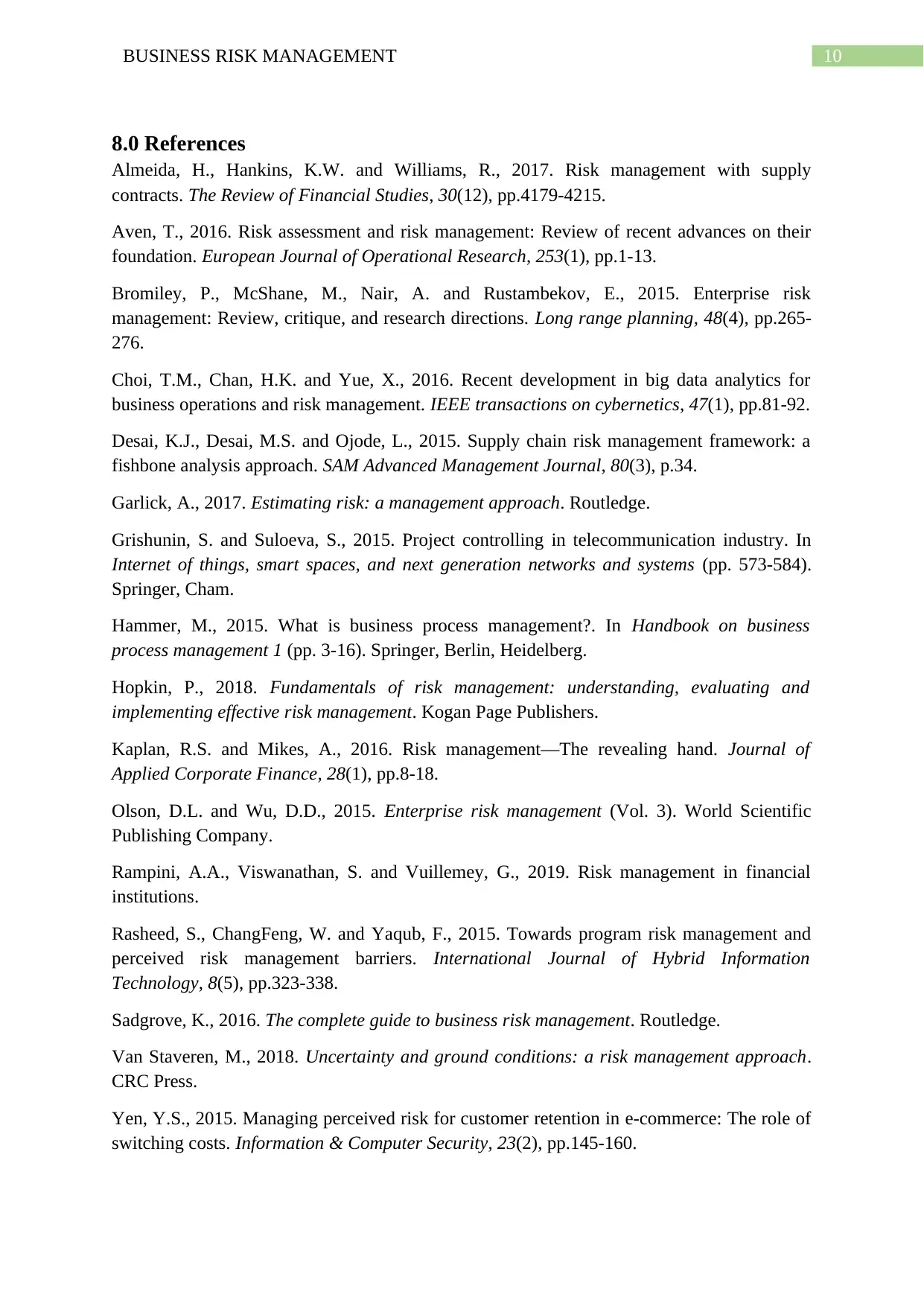
10BUSINESS RISK MANAGEMENT
8.0 References
Almeida, H., Hankins, K.W. and Williams, R., 2017. Risk management with supply
contracts. The Review of Financial Studies, 30(12), pp.4179-4215.
Aven, T., 2016. Risk assessment and risk management: Review of recent advances on their
foundation. European Journal of Operational Research, 253(1), pp.1-13.
Bromiley, P., McShane, M., Nair, A. and Rustambekov, E., 2015. Enterprise risk
management: Review, critique, and research directions. Long range planning, 48(4), pp.265-
276.
Choi, T.M., Chan, H.K. and Yue, X., 2016. Recent development in big data analytics for
business operations and risk management. IEEE transactions on cybernetics, 47(1), pp.81-92.
Desai, K.J., Desai, M.S. and Ojode, L., 2015. Supply chain risk management framework: a
fishbone analysis approach. SAM Advanced Management Journal, 80(3), p.34.
Garlick, A., 2017. Estimating risk: a management approach. Routledge.
Grishunin, S. and Suloeva, S., 2015. Project controlling in telecommunication industry. In
Internet of things, smart spaces, and next generation networks and systems (pp. 573-584).
Springer, Cham.
Hammer, M., 2015. What is business process management?. In Handbook on business
process management 1 (pp. 3-16). Springer, Berlin, Heidelberg.
Hopkin, P., 2018. Fundamentals of risk management: understanding, evaluating and
implementing effective risk management. Kogan Page Publishers.
Kaplan, R.S. and Mikes, A., 2016. Risk management—The revealing hand. Journal of
Applied Corporate Finance, 28(1), pp.8-18.
Olson, D.L. and Wu, D.D., 2015. Enterprise risk management (Vol. 3). World Scientific
Publishing Company.
Rampini, A.A., Viswanathan, S. and Vuillemey, G., 2019. Risk management in financial
institutions.
Rasheed, S., ChangFeng, W. and Yaqub, F., 2015. Towards program risk management and
perceived risk management barriers. International Journal of Hybrid Information
Technology, 8(5), pp.323-338.
Sadgrove, K., 2016. The complete guide to business risk management. Routledge.
Van Staveren, M., 2018. Uncertainty and ground conditions: a risk management approach.
CRC Press.
Yen, Y.S., 2015. Managing perceived risk for customer retention in e-commerce: The role of
switching costs. Information & Computer Security, 23(2), pp.145-160.
8.0 References
Almeida, H., Hankins, K.W. and Williams, R., 2017. Risk management with supply
contracts. The Review of Financial Studies, 30(12), pp.4179-4215.
Aven, T., 2016. Risk assessment and risk management: Review of recent advances on their
foundation. European Journal of Operational Research, 253(1), pp.1-13.
Bromiley, P., McShane, M., Nair, A. and Rustambekov, E., 2015. Enterprise risk
management: Review, critique, and research directions. Long range planning, 48(4), pp.265-
276.
Choi, T.M., Chan, H.K. and Yue, X., 2016. Recent development in big data analytics for
business operations and risk management. IEEE transactions on cybernetics, 47(1), pp.81-92.
Desai, K.J., Desai, M.S. and Ojode, L., 2015. Supply chain risk management framework: a
fishbone analysis approach. SAM Advanced Management Journal, 80(3), p.34.
Garlick, A., 2017. Estimating risk: a management approach. Routledge.
Grishunin, S. and Suloeva, S., 2015. Project controlling in telecommunication industry. In
Internet of things, smart spaces, and next generation networks and systems (pp. 573-584).
Springer, Cham.
Hammer, M., 2015. What is business process management?. In Handbook on business
process management 1 (pp. 3-16). Springer, Berlin, Heidelberg.
Hopkin, P., 2018. Fundamentals of risk management: understanding, evaluating and
implementing effective risk management. Kogan Page Publishers.
Kaplan, R.S. and Mikes, A., 2016. Risk management—The revealing hand. Journal of
Applied Corporate Finance, 28(1), pp.8-18.
Olson, D.L. and Wu, D.D., 2015. Enterprise risk management (Vol. 3). World Scientific
Publishing Company.
Rampini, A.A., Viswanathan, S. and Vuillemey, G., 2019. Risk management in financial
institutions.
Rasheed, S., ChangFeng, W. and Yaqub, F., 2015. Towards program risk management and
perceived risk management barriers. International Journal of Hybrid Information
Technology, 8(5), pp.323-338.
Sadgrove, K., 2016. The complete guide to business risk management. Routledge.
Van Staveren, M., 2018. Uncertainty and ground conditions: a risk management approach.
CRC Press.
Yen, Y.S., 2015. Managing perceived risk for customer retention in e-commerce: The role of
switching costs. Information & Computer Security, 23(2), pp.145-160.
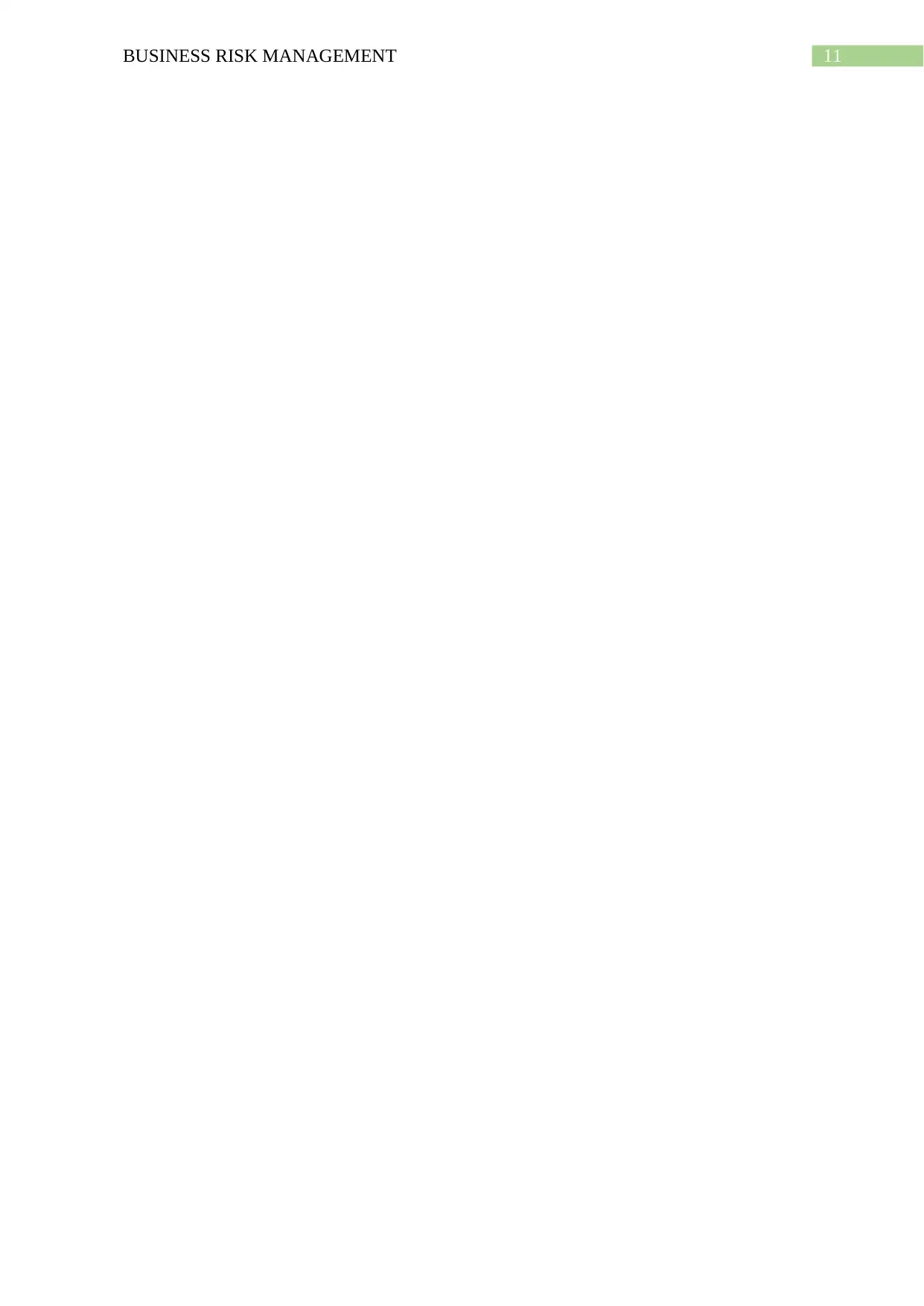
11BUSINESS RISK MANAGEMENT
1 out of 12
Related Documents
Your All-in-One AI-Powered Toolkit for Academic Success.
+13062052269
info@desklib.com
Available 24*7 on WhatsApp / Email
![[object Object]](/_next/static/media/star-bottom.7253800d.svg)
Unlock your academic potential
© 2024 | Zucol Services PVT LTD | All rights reserved.





